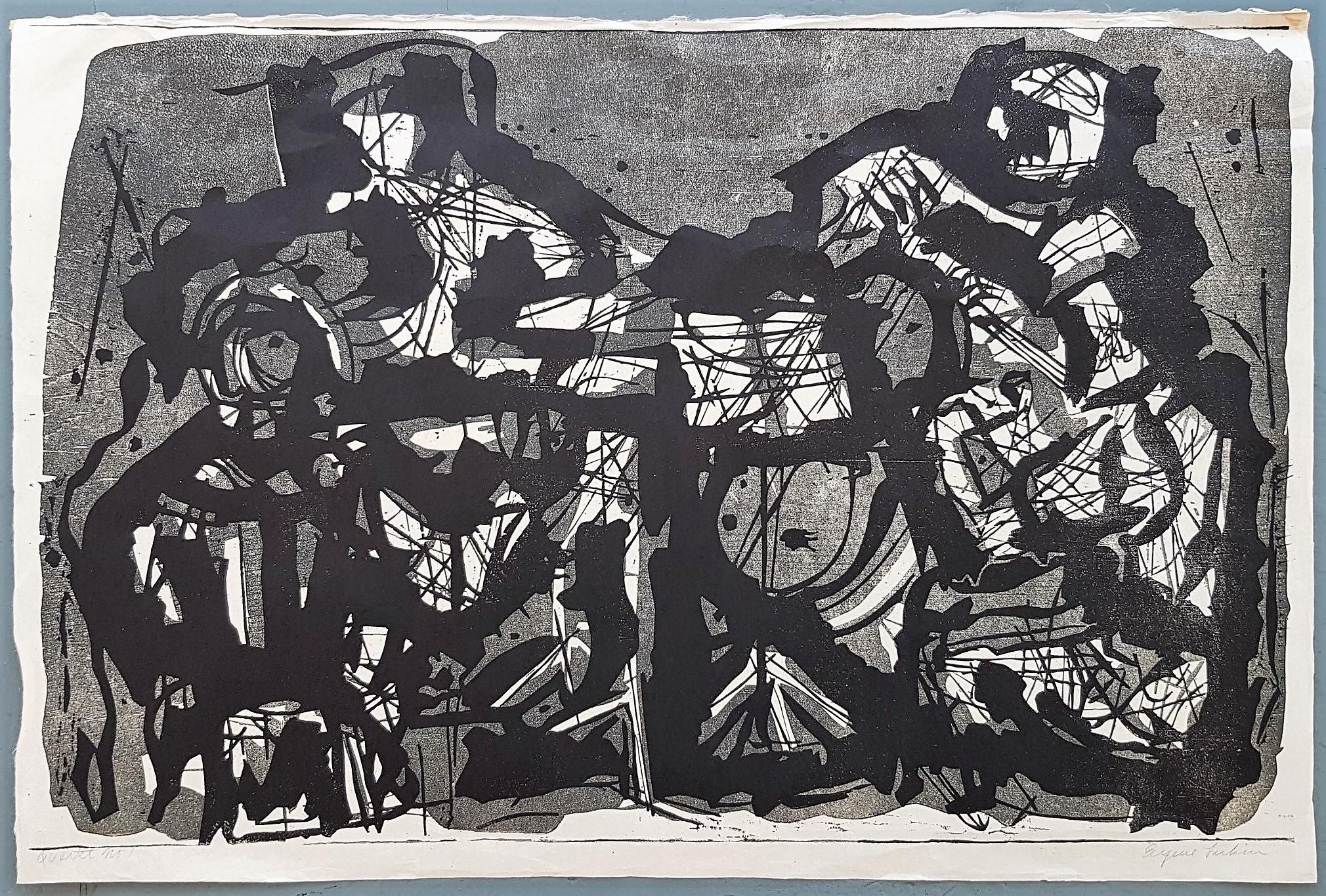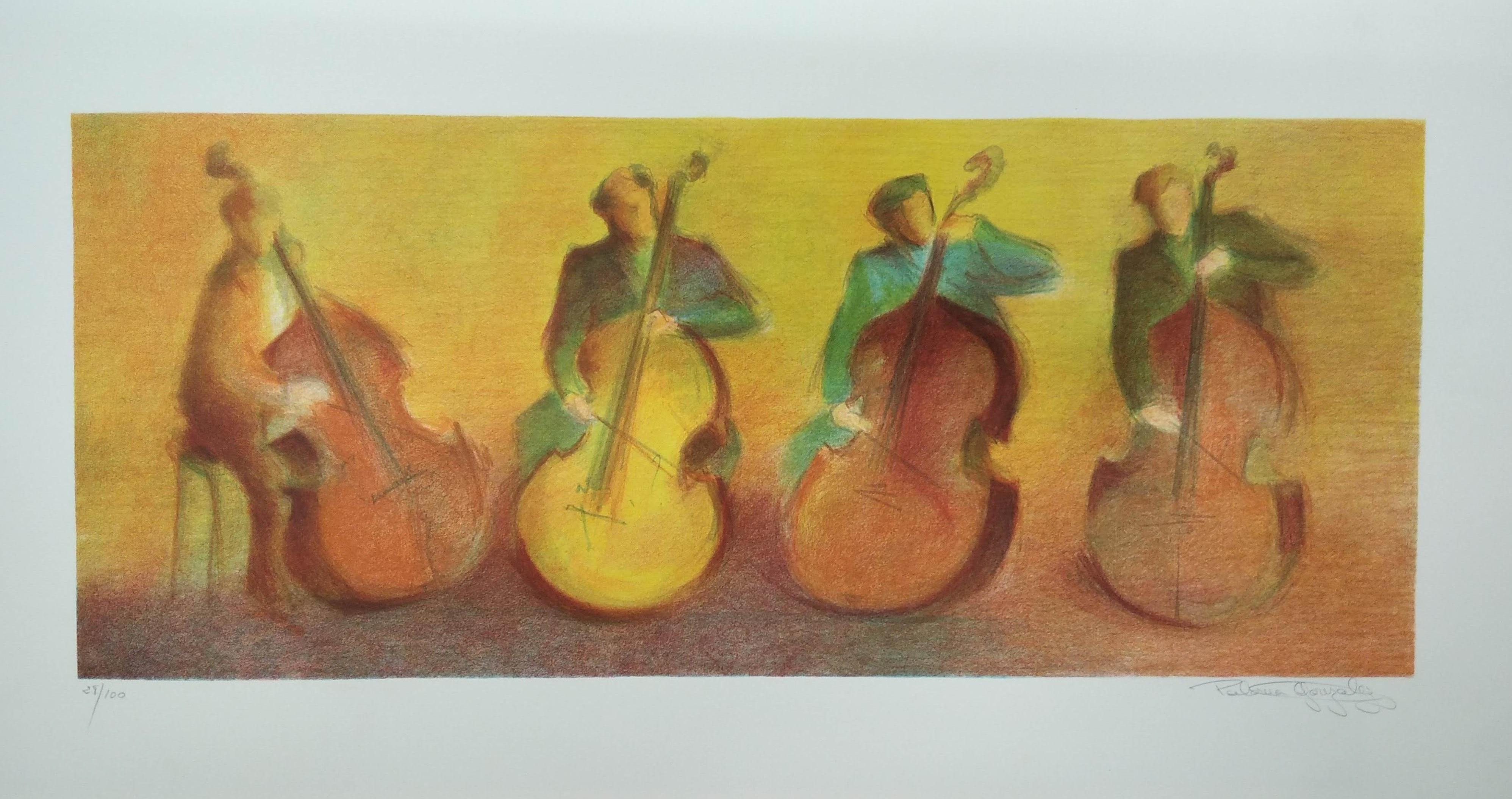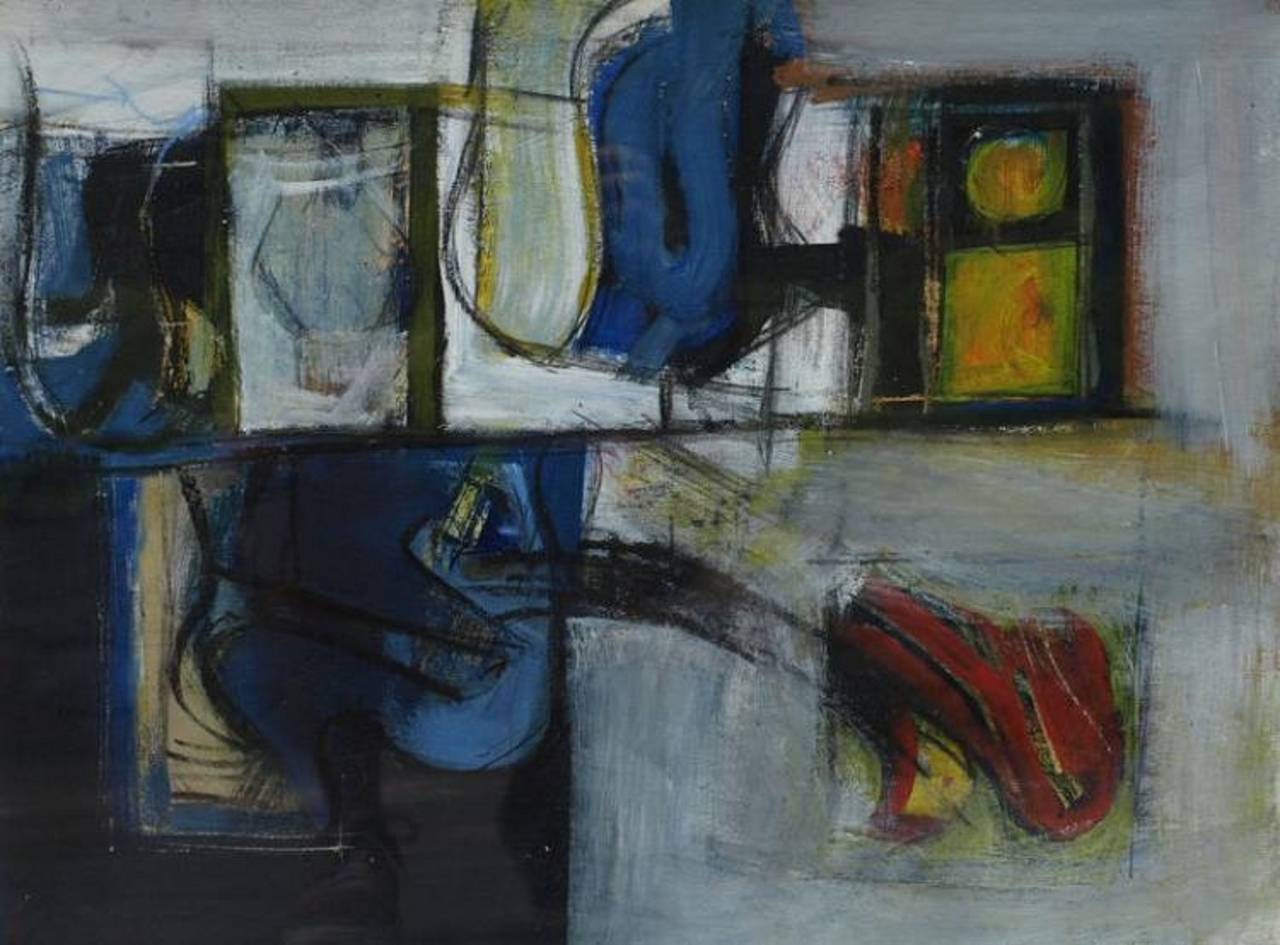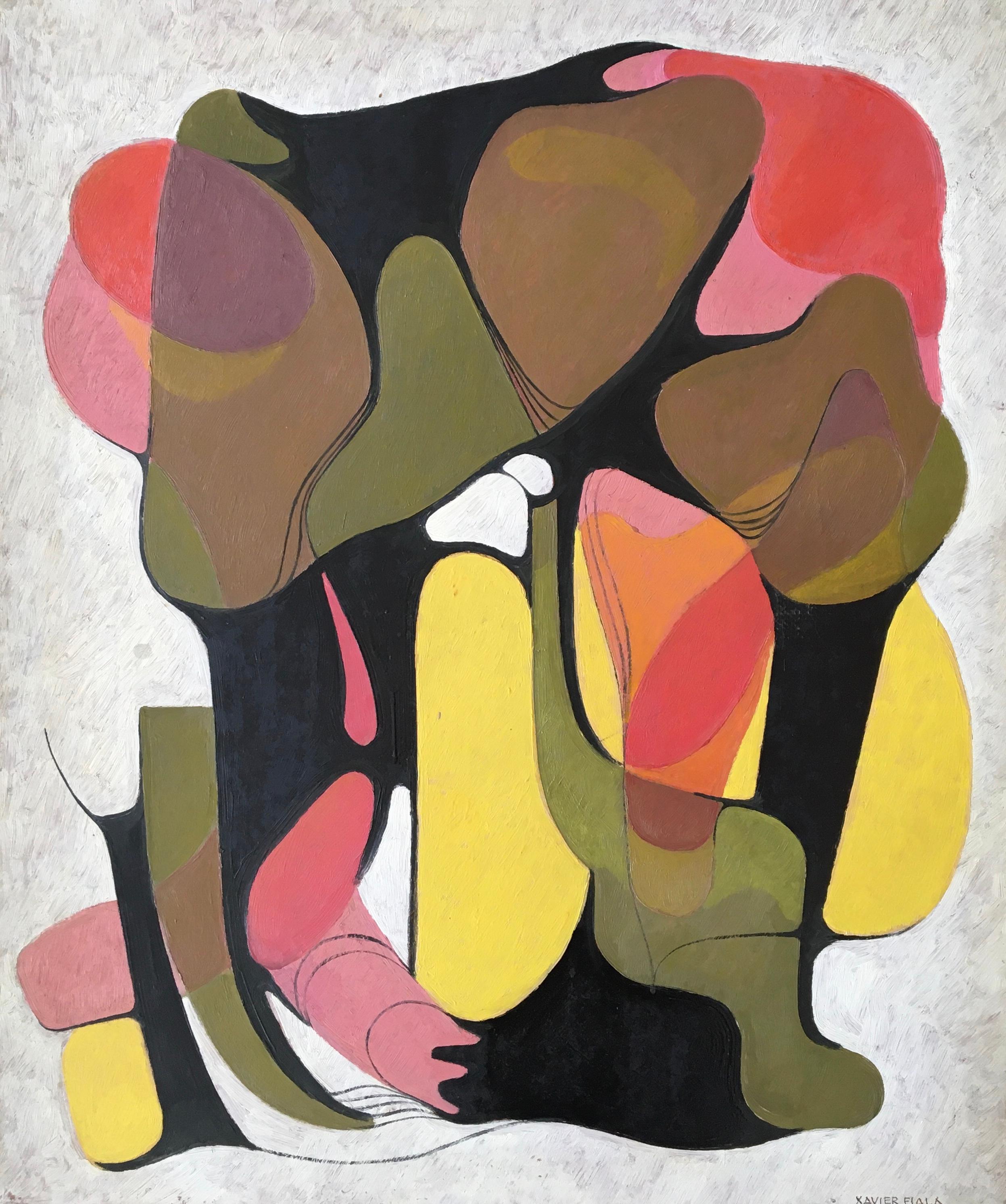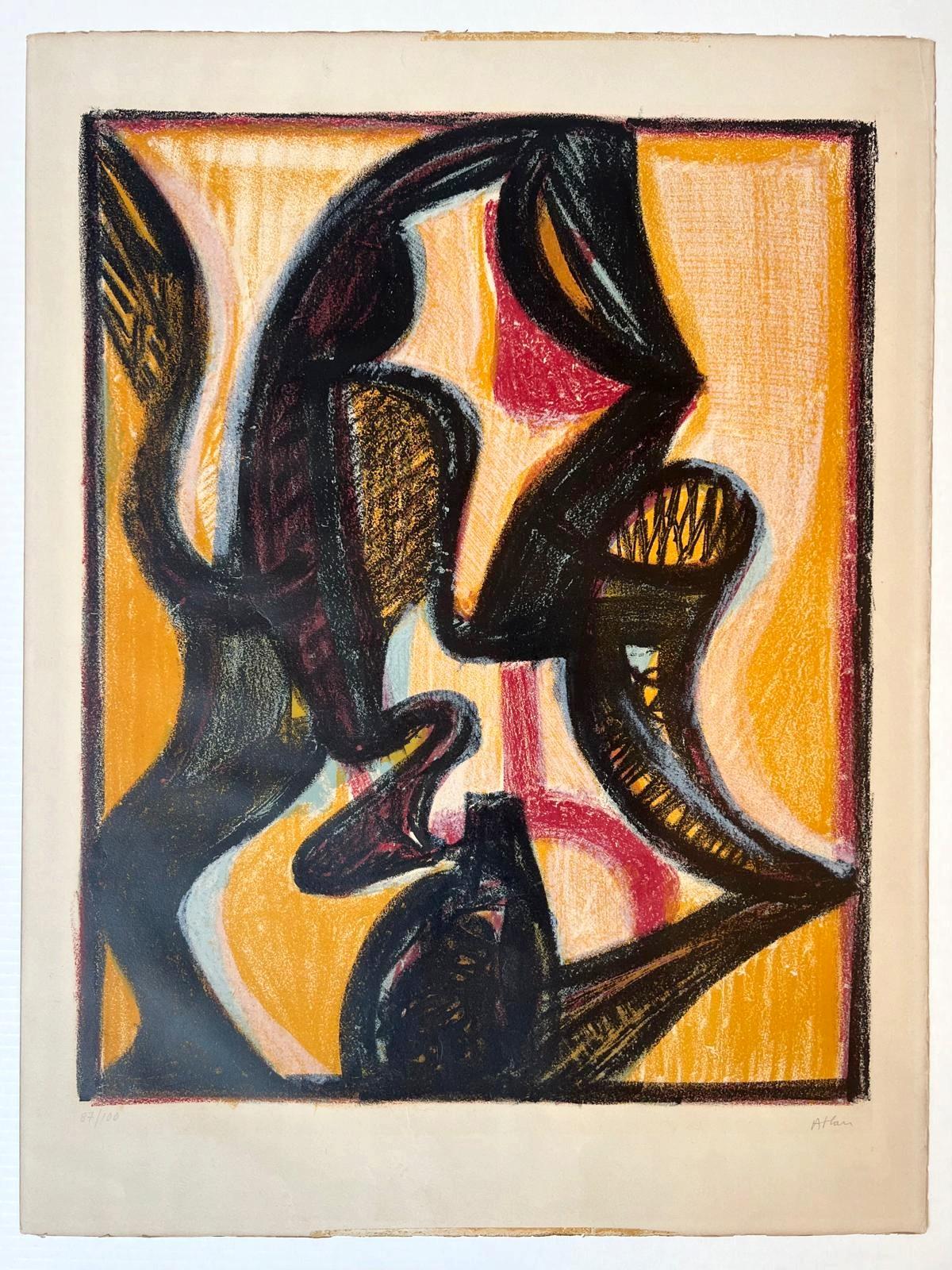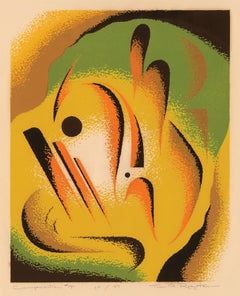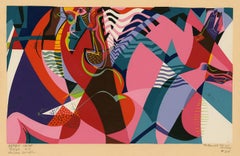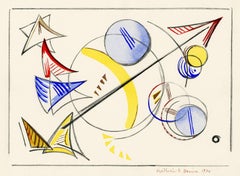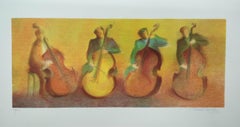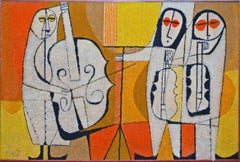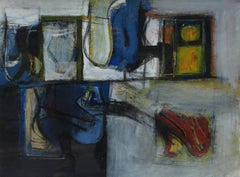Items Similar to 'Quintet' — Mid-Century Modernism, Atelier 17
Want more images or videos?
Request additional images or videos from the seller
1 of 5
Terry Haass'Quintet' — Mid-Century Modernism, Atelier 17c. 1948
c. 1948
$2,200
£1,671.26
€1,925.02
CA$3,147.32
A$3,451.78
CHF 1,780.23
MX$41,234.40
NOK 22,578.68
SEK 21,181.36
DKK 14,381.35
About the Item
Terry Haass, 'Quintet', etching and aquatint, edition 20, c. 1948. Signed, titled, and numbered '12/20' in pencil. A superb, richly-inked impression, on off-white wove paper, with full margins (1 7/16 to 2 7/16 inches), in excellent condition. Scarce. Matted to museum standards, unframed.
Haass captures the vibrancy of a mid-century jazz quintet with the broad tonal range of her dynamic, modernist composition.
ABOUT THE ARTIST
Terry Haass (1923–2016) was a Czech-born artist whose career spanned painting, printmaking, and sculpture, and whose work was deeply shaped by displacement, exile, and the search for universal forms of expression.
Terry Haass was born Terezie Haassová in Český Těšín, Czechoslovakia. In 1938, amid the rising threat of Nazism, she and her family fled to Paris, and soon after to New York, where she spent much of her early adult life. Haass studied at the Art Students League of New York, as well as at the Atelier 17, the experimental print workshop led by Stanley William Hayter, where she joined an influential circle of émigré and American artists engaged with modernist printmaking.
During the 1940s and 1950s, Haass became known for her innovative use of intaglio and relief techniques, pushing printmaking beyond traditional boundaries. She worked alongside artists such as Joan Miró, André Masson, and Yves Tanguy, absorbing influences of Surrealism and Abstract Expressionism while developing her own distinctive style. Her prints often feature abstract geometric structures combined with lyrical, organic forms, embracing the qualities of dynamism, elegance and spontaneity.
By the 1950s, Haass had established herself internationally, exhibiting in both Europe and the United States. She returned to Paris permanently in 1951, continuing to create and exhibit widely. Her later work expanded into painting and sculpture, where she explored spatial relationships, transparency, and light—often constructing works with Plexiglas and other modern materials.
Haass exhibited at major institutions throughout her career, including the Museum of Modern Art (New York), the Art Institute of Chicago, and the Bibliothèque nationale de France. She participated in numerous international exhibitions of printmaking, and her work was shown in both solo and group contexts across Europe and the U.S. In the 1950s she was included in the Carnegie International Exhibition in Pittsburgh, one of the most prestigious showcases of contemporary art at the time.
Her work bridges several movements—Surrealism, Abstract Expressionism, and Constructivist abstraction—while never fitting neatly into any one school. She was especially drawn to the dichotomy of order and chaos, geometry and gesture, materiality and immateriality. Her experimental use of printmaking techniques inspired younger artists, and her sculptural work with transparent and reflective materials anticipated later explorations in Minimalism and Light and Space art.
Haass lived and worked primarily in Paris from the 1950s until her death. She continued to create art into her later years, with retrospectives and renewed critical attention in the early 21st century highlighting her contributions as a pioneering woman artist in both printmaking and sculpture.
Museums representing work by Haass include the Olomouc Museum of Art (Czech Republic), Art Institute of Chicago, Brooklyn Museum, Library of Congress, National Gallery of Art, Metropolitan Museum of Art, Victoria & Albert Museum (London), Museum of Modern Art, RISD Museum, Smithsonian American Art Museum, Whitney Museum of American Art, and the Cleveland Museum of Art.
- Creator:Terry Haass (1923 - 2016, American)
- Creation Year:c. 1948
- Dimensions:Height: 8.75 in (22.23 cm)Width: 11.88 in (30.18 cm)
- Medium:
- Movement & Style:
- Period:
- Condition:
- Gallery Location:Myrtle Beach, SC
- Reference Number:Seller: 998971stDibs: LU53232626543
About the Seller
5.0
Recognized Seller
These prestigious sellers are industry leaders and represent the highest echelon for item quality and design.
Platinum Seller
Premium sellers with a 4.7+ rating and 24-hour response times
Established in 1995
1stDibs seller since 2016
325 sales on 1stDibs
Typical response time: 1 hour
Associations
International Fine Print Dealers Association
- ShippingRetrieving quote...Shipping from: Myrtle Beach, SC
- Return Policy
Authenticity Guarantee
In the unlikely event there’s an issue with an item’s authenticity, contact us within 1 year for a full refund. DetailsMoney-Back Guarantee
If your item is not as described, is damaged in transit, or does not arrive, contact us within 7 days for a full refund. Details24-Hour Cancellation
You have a 24-hour grace period in which to reconsider your purchase, with no questions asked.Vetted Professional Sellers
Our world-class sellers must adhere to strict standards for service and quality, maintaining the integrity of our listings.Price-Match Guarantee
If you find that a seller listed the same item for a lower price elsewhere, we’ll match it.Trusted Global Delivery
Our best-in-class carrier network provides specialized shipping options worldwide, including custom delivery.More From This Seller
View All'Composition # 4' — Mid-Century Modernism
By Thomas A. Robertson
Located in Myrtle Beach, SC
Thomas Robertson, 'Composition #4,' color serigraph, edition 47, c. 1940. Signed, titled, and annotated 'Ed/47' in pencil. A superb, painterly impression, with fresh colors, on buff wove paper, the full sheet with margins (1 to 2 inches), in excellent condition. Matted to museum standards, unframed.
Image size: 10 9/16 x 8 1/2 inches (268 x 216 mm); sheet size 13 x 12 1/2 inches (330 x 318 mm).
An impression of this work is represented in the collection of the National Gallery of Art.
ABOUT THE ARTIST
Born in Little Rock, Arkansas, Thomas Arthur Robertson (1911-1976) was the son of an attorney. Although his father, a co-owner of the Arkansas Law School, insisted that his son study there, after graduating, Robertson enrolled at the Adrian Brewer...
Category
1940s Abstract Abstract Prints
Materials
Screen
'Variation 8, Vol. I' — from the series '1 to 40 Variations'
By Katherine S. Dreier
Located in Myrtle Beach, SC
Katherine S. Dreier, 'Variation 8, Vol. 1' from '1 to 40 Variations', lithograph with pochoir and hand-coloring, 1934, edition 65. Stenciled signature and date, lower right. Annotate...
Category
1930s American Modern Abstract Prints
Materials
Lithograph
Sister Kate — Mid-century, Jazz-inspired Modernism
By James Houston McConnell
Located in Myrtle Beach, SC
James Houston McConnell, 'Sister Kate', color serigraph, 1947, edition 24. Signed, dated, titled, and numbered '24' in pencil. Annotated '10.00 - 19 colors - 24 copies - #24' in pencil. A fine impression, with vibrant, fresh colors, on heavy tan wove paper, with full margins (11/16 to 1 1/2 inches). Tack holes in the four margin corners, well away from the image, otherwise in excellent condition. Matted to museum standards, unframed. Scarce.
Another of McConnell's mid-century modernist, jazz-inspired serigraphs, 'Combo', is featured in the British Museum's 2008 publication (and traveling exhibition) 'The American Scene: Prints from Hopper to Pollock'.
ABOUT THE IMAGE
"I Wish I Could Shimmy Like My Sister Kate", often simply "Sister Kate", is an up-tempo jazz dance song, written by Armand J. Piron and published in 1922. The lyrics of the song are narrated in the first person by Kate's sister, who sings about Kate's impressive dancing skill and her wish to be able to emulate it. She laments that she's not quite "up to date", but believes that dancing like "Sister Kate" will rectify this, and she will be able to impress "all the boys in the neighborhood" like her sister.
Over the years this song has been performed and recorded by many artists, including Frances Faye and Rusty Warren, a 1959 version by Shel Silverstein...
Category
1940s American Modern Abstract Prints
Materials
Screen
Variation 4, Vol. I
By Katherine Sophie Dreier
Located in Myrtle Beach, SC
Katherine S. Dreier, 'Variation 4, Vol. I' from '1 to 40 Variations', lithograph with pochoir and hand-coloring, 1934, edition 65. Stenciled signature and date, lower right. Annotate...
Category
Mid-20th Century American Modern Abstract Prints
Materials
Watercolor, Lithograph, Stencil
'Variation 30, Vol. II' — from the series '1 to 40 Variations'
By Katherine S. Dreier
Located in Myrtle Beach, SC
Katherine S. Dreier, 'Variation 30, Vol. II' from '1 to 40 Variations', lithograph with pochoir and hand-coloring, 1934, edition 65. Stenciled signature and date, lower right. Annota...
Category
1930s American Modern Abstract Prints
Materials
Lithograph
'Astral Comic' — Modernist Abstraction
By Edward August Landon
Located in Myrtle Beach, SC
Edward Landon 'Astral Comic', color serigraph, 1978, edition 25, Ryan 12. Signed, titled, and annotated 'Edition 25' in pencil. A superb, painterly impression, with fresh colors, on ...
Category
1970s Abstract Abstract Prints
Materials
Screen
You May Also Like
Quartet No. 1
By Eugene Larkin
Located in Kansas City, MO
Eugene Larkin
Quartet No. 1
Woodcut in two colors
Signed and titled by hand
Size: 20 x 29.5 inches
COA provided
Eugene Larkin (1921-2010)
The late Eugene Larkin was an artist who worked in the Twin Cities area for many years and needs little introduction. His works have been shown, collected and appreciated by numerous galleries, museums and collectors throughout the United States.
Larkin was influential both as an artist and as a teacher. He taught at the Minneapolis College of Art and Design between 1954 and 1969, where he was head of printmaking and Chairman of the Division of Fine Arts. From 1969-1991 he was a professor in the Design Department at the University of Minnesota.
Eugene Larkin, a lithographer, teacher and artist who left behind scores of works, some of them in the permanent collections of the Library of Congress and the Museum of Modern Art. He was considered an early promoter of lithography education, Larkin introduced it into arts programs while teaching at the Minneapolis College of Art and Design and the University of Minnesota. He held a prominent place in the art world through decades of working and teaching in Minneapolis. His work depicted a wide range of subjects, from musicians to nature, including a series of woodcuts based on William Blake's ""Songs of Innocence and Experience."
Larkin also wrote a textbook, ""Design: The Search for Unity."" It was his work with lithography, an 18th-century printmaking process, for which he was best known.
His last local exhibit was a retrospective at The University of Minnesota Weisman Museum in 2005. ""Sometimes I start the artistic process from a literary source - Adam and Eve, the Egyptian nature gods, or classical Greek themes but sometimes I start from nature. Trees have always been a favorite subject. I see trees as people, as vertical objects...
Category
15th Century and Earlier Modern Prints and Multiples
Materials
Woodcut
Untitled
Located in Barcelona, BARCELONA
original and certificated by gallery
Category
Early 2000s Abstract Abstract Paintings
Materials
Paper, Ink
Jazz Players
Located in Missouri, MO
Jazz Players by Bill Hinz (1920-2009)
Signature in Textile Bottom Left
Unframed: 41.5" x 64"
Framed: 42.5" x 64.75"
Unique Piece made entirely out of a s...
Category
20th Century American Modern More Art
Materials
Textile
Price Upon Request
Abstract
By Harry Nadler
Located in Saratoga Springs, NY
Singed verso.
An abstract painter who lived in New York City; Amagansett, Long Island, and Albuquerque, New Mexico, Harry Nadler is described as a "formalist abstract painter of t...
Category
Abstract Abstract Paintings
Materials
Archival Paper, Mixed Media
$4,500
Four
Located in Genève, GE
Work on wood
Category
Mid-20th Century Abstract Abstract Paintings
Materials
Oil
$1,010
East
Located in Paris, FR
Lithograph, 1957
Handsigned by the artist in pencil and numbered 87/100
Publisher : Editions le Musée de Poche, Paris
Printer : Jean Pons
Catalog : [Polieri 1747]
66.00 cm. x 50.00 c...
Category
1950s Abstract Abstract Prints
Materials
Lithograph
More Ways To Browse
Michael Hale On Sale
Michael Robbins
Michael Ross
Miro Constellations
Miro Lithograph Sun
Miro Oda
Motherwell London Series
Ouchi Makoto
Paul Caulfield
Paula Crane
Picasso Arnera
Picasso Print Signed Dove
Picasso Serigraph
Picasso Weeping Woman
Portfolio 9 1967
Rene Magritte Hand Signed
Robert Indiana Heliotherapy
Robert Indiana Love Heliotherapy
